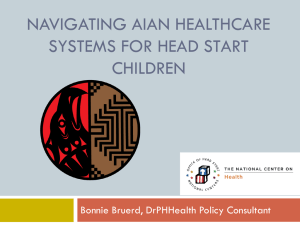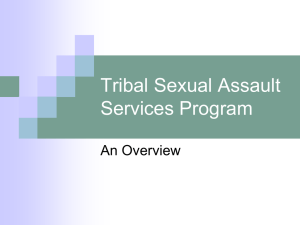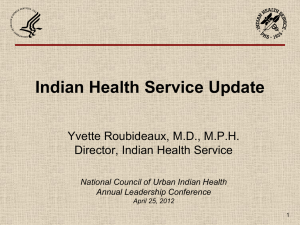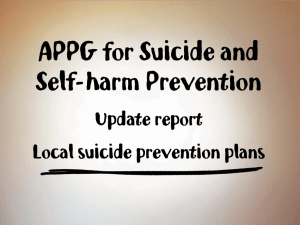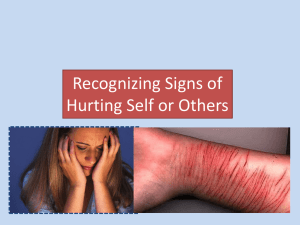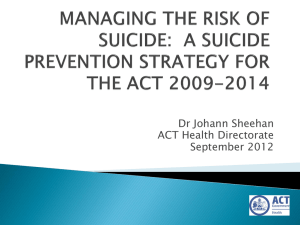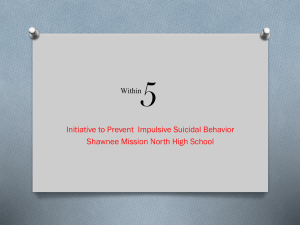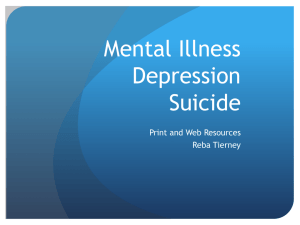4. NIHB_BH_Updates - National Indian Health Board
advertisement
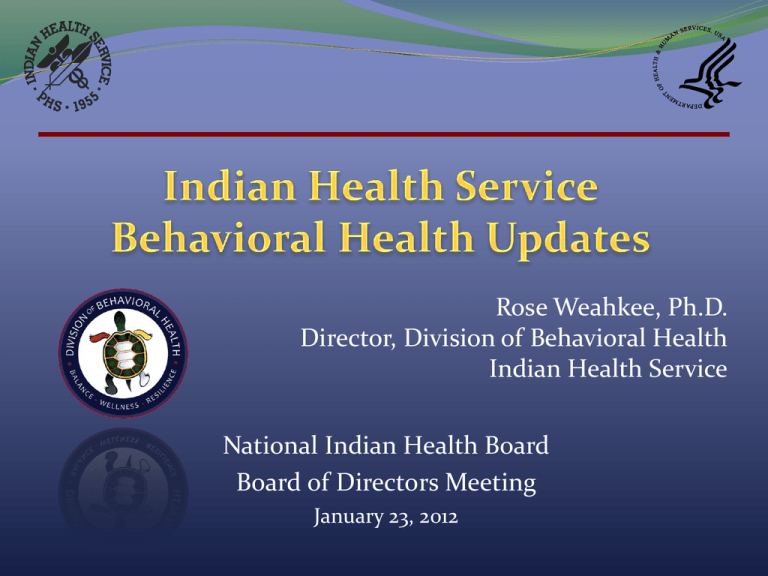
Rose Weahkee, Ph.D. Director, Division of Behavioral Health Indian Health Service National Indian Health Board Board of Directors Meeting January 23, 2012 Federal Efforts in Suicide Prevention: Indian Health Service Indian Health Service Suicide Prevention Initiative The National Suicide Prevention Initiative addresses the tragedy of suicide in American Indian and Alaska Native communities. The IHS National Suicide Prevention Initiative builds on the foundation of the HHS “National Strategy for Suicide Prevention” and the 11 goals and objectives for the Nation to reduce suicidal behavior and its consequences, while ensuring we honor and respect Tribal traditions and practices. Available at: www.ihs.gov/MedicalPrograms/Behavioral IHS Suicide Prevention Initiative Five strategic objectives: Assist IHS, Tribal, and Urban Indian programs and communities in addressing suicide utilizing community level cultural approaches. Identify and share information on best and promising practices. Improve access to behavioral health services. Strengthen and enhance IHS’ epidemiological capabilities. Promote collaboration between Tribal and Urban Indian communities with Federal, State, national, and local community agencies. Promoting Collaboration The National Action Alliance for Suicide Prevention was launched in Sept 2010 by HHS Secretary Sebelius and Defense Secretary Gates The AI/AN Task Force, co-chaired by Dr. Yvette Roubideaux, IHS Director, Mr. Larry Echohawk, Asst. Sec. for Indian Affairs , and McClellan Hall, private sector representative was formed to implement suicide prevention strategies to reduce the rate of suicide in AI/AN communities. Suicide Listening Sessions Listening Sessions IHS, SAMHSA, and the Department of Interior Bureau of Indian Affairs and Bureau of Indian Education held ten Tribal listening sessions across Indian Country to seek input on how the agencies can most effectively work in partnership with AI/AN communities to prevent suicide. Listening Sessions Listening Sessions were conducted from November 2010 to February 2011. Navajo Region – Nov. 15, 2010 Rocky Mountain Region – Nov. 19, 2010 Alaska Region- Nov. 30, 2010 Great Plains Region – Dec. 2, 2010 Southern Plains Region/ Eastern OK- Dec. 13, 2010 Pacific Region – Dec. 21, 2010 Southwest Region – Jan. 10, 2011 Northwest Region – Jan. 12, 2011 Eastern Region – Feb. 10, 2011 Listening Sessions The information gathered was used to build the foundation of training and best practices program featured in the Action Summits for Suicide Prevention held in August 2011 in Scottsdale, AZ and October 2011 in Anchorage, AK TribalRecommendations Address Contributing Factors Suicide is a public health issue with many contributing factors, including alcoholism, substance abuse, poverty, unemployment, and trauma. Recommendation: Contributing factors should be included in overall suicide prevention planning. Additional funding is needed to address substance abuse and domestic violence. Tribal Recommendations Behavioral Health Staffing There exists a lack of culturally-competent behavioral health professionals trained in suicide and suicide related prevention and intervention treatment modalities. Recommendation: Increase the availability of behavioral health staff trained in suicide and suicide related prevention and intervention in Indian Country. Tribal Recommendations Improvement of Services Current staffing levels, breadth of services and hours of service do not meet the need for community-based suicide prevention and intervention activities. Recommendation: Expansion of services are needed - Tele-psychiatry services, inpatient psychiatric services, family support, positive parenting services, safe houses, and transportation services to improve access. Tribal Recommendations Communication and coordination of activities and resources between private and public sector agencies need improvement. Recommendation: Federal partners should work to coordinate stakeholders and Tribal communities to improve communication and enhance collaboration. Tribal Recommendations A Tribal Suicide Summit should be held at the national level and in Alaska that focuses on sharing best or promising practice based suicide prevention programs. Action Summits for Suicide Prevention Two Action Summits for Suicide Prevention were held in Scottsdale AZ from August 1-4, 2011; and in Alaska from October 25-27, 2011 In total, over 1,000 attendees received preconference training and attended multiple workshop tracks, including suicide and substance abuse prevention, serving at risk youth, clinical practice, incident response, methamphetamine , public health communications, and many more Action Summits for Suicide Prevention Focus Areas: Trainings offered in best and promising practices in suicide prevention Prevention/Screening Focus Intervention/Treatment Focus Aftercare/Postvention Focus Action Summits for Suicide Prevention Objectives: To emphasize an action-focused approach to suicide prevention. Presentation materials were combined to produce a suicide prevention toolkit. Participants were encouraged to take toolkits back to their communities for new program implementation or to strengthen current program sustainability. Action Summits for Suicide Prevention Summit toolkits available at: http://www.ihs.gov/suicidepreventionsum mit/ http://www.ihs.gov/suicidepreventionsum mit/alaska Action Summits for Suicide Prevention Three major AI/AN Suicide Prevention and Behavioral Health documents were launched at the Action Summits: o AI/AN National Suicide Prevention Strategic Plan o AI/AN National Behavioral Health Strategic Plan o AI/AN Behavioral Health Briefing Book Next Steps Continue Federal Collaborations in partnership with Tribes in the implementation of the SP Strategic Plan Continue improving access to culturally competent behavioral health care Provide ongoing training for health care providers as well as community members to enable comprehensive community-based prevention Promote the use of culturally-based promising and traditional practices in prevention of suicide Coordinate and leverage existing resources to better meet the need for suicide prevention activities Federal Efforts in Violence Prevention: Indian Health Service IHS Sexual Assault Policy The Tribal Law and Order Act requires the IHS Director to develop sexual assault policies and protocols based on similar protocols established by the Department of Justice (DOJ). IHS established its first formal Sexual Assault Policy on March 23, 2011. The IHS consulted with Tribal leaders and received comments for incorporation in future revisions. Tribal Comments Common themes for IHS SA Policy Revisions: Expand policy to clinics Clarification on utilization of victim advocates Adopting timelines for policy development Referencing Tribal codes in the policy Clarification of transportation section of policy Provision of exams on-site, by referral, or combination of both methods Removing certification requirements for sexual assault examiners Next Steps IHS planning recommendations for ongoing improvements for domestic violence and sexual assault services: Complete revisions of the IHS Sexual Assault Policy based on comments received from Tribes, Urban Indian leadership, the DOJ and the GAO; Develop an IHS Sexual Assault Policy Implementation and Monitoring Plan; Given the focus of the current IHS Sexual Assault Policy on hospital-based care, develop a sexual assault policy for all IHS facilities, such as outpatient clinics and health stations; Next Steps cont’d Offer SANE-SAFE-SART training and provide forensic examination equipment for all 28 IHS and 17 Tribal hospitals by December 2012; Develop and offer domestic violence/sexual assault training and curriculum for Indian Health System facilities; and Develop new/updated IHS policies and procedures for domestic violence, child sexual abuse, and elder abuse. IHS Partnerships Strategies to address domestic violence and sexual assault include collaborations and partnerships with: Consumers and their families, Tribes and Tribal organizations, Urban Indian health programs, Federal, State, and local agencies Public and private organizations IHS and ACF Collaborated to fund over 35 sites to identify strategies and develop interventions to address domestic violence in AI/AN communities. Trained medical and nursing staff to screen for domestic violence and to provide safety planning for all female patients, Forged community partnerships, Developed policies and procedures on domestic violence. Sites developed: culturally sensitive screening tools, policies and procedures, informational brochures. IHS and DOJ The IHS and the DOJ Office for Victims of Crime (OVC) entered into a partnership involving the Federal Bureau of Investigation and the Department of the Interior to develop the AI/AN SANE-SART Initiative. The goal of the SANE/SART Initiative is to address the needs of sexual assault victims in Indian Country. To address this overall goal, the project will identify, assess, and support existing SANE and SART efforts by providing training and technical assistance resources for all of the IHS and OVC funded SANE/SART programs, and through the development of comprehensive SANE/SART demonstration projects. OVC SANE-SART AI/AN Initiative Three tribal communities funded: Mississippi Band of Choctaw Indians Tuba City Health Care Corporation Southern Indian Health Council, Inc. Three sites funded to: Identify a SANE-SART Coordinator Establish a framework for a SANE-SART Team Involve community stakeholders Conduct comprehensive needs assessment Develop a strategic plan to enhance and/or create a sustainable, culturally relevant, victim centered SANE/SART program. IHS Priorities In Action • National Tribal Advisory Committee on Behavioral Health • National Behavioral Health Work Group • Methamphetamine and Suicide Prevention Initiative • Domestic Violence Prevention Initiative National Tribal Advisory Committee (NTAC) on Behavioral Health The IHS National Tribal Advisory Committee on Behavioral Health embodies all of the IHS priorities Elected Tribal officials from each IHS Area provide recommendations and advice on the range of behavioral health issues in Indian Country NTAC is the principal Tribal advisory group for all behavioral health services to the IHS Director Provide recommendations on significant funding allocations and service programs Develop long term strategic plans for Tribal and Federal behavioral health programs National Behavioral Health Work Group (BHWG) The IHS National Behavioral Health Work Group works very closely with the NTAC to provide collaborative links between the professional community and national Tribal leadership: • National technical advisory group to the NTAC and the • • • • Division of Behavioral Health Comprised of mental health professionals from across the country Strengthen partnerships Improve quality and access to care Direct collaboration across Tribal and Federal behavioral health system What is the Methamphetamine and Suicide Prevention Initiative (MSPI) Demonstration pilot program Provides $16.4 million annually to existing or innovative Tribal, Tribal organizations, Federally-Operated, and Urban Indian health programs to provide methamphetamine and/or suicide prevention and treatment services. NTAC MSPI Consultation Consultation and Collaboration over one year NTAC developed program and funding distribution recommendations Director accepted those recommendations without alteration Together developed innovative funding mechanisms Together endorsed community developed and delivered programs MSPI Establish evidence based or practice based methamphetamine and suicide prevention and intervention pilot projects. Represent innovative partnerships with IHS to deliver services by and for the communities themselves, with a national support network for ongoing program development and evaluation. MSPI 127 IHS, Tribal, Youth, Urban Pilot Projects 112 Tribal and IHS awardees Includes 3 Youth Regional Treatment Centers (YRTCs) 12 Urban grantees 3 Tribal Youth grantees MSPI Area Program Recipients Number of MSPI Recipients by Area Number of MSPI Funded Recipients 25 22 20 17 15 15 11 10 11 9 8 8 6 9 7 5 2 0 2 Year One Activities Of those MSPI programs who have reported to date, a total of 289,066 persons have been served through both prevention and treatment activities. Prevention activities include, but are not limited to: Evidence-based practice training Knowledge dissemination Development of public service announcements and publications Coalition development Crisis hotline enhancement Baseline Measures Outcome Measure # 4: (66%) The proportion of youth who participate in evidencebased and/or promising practice prevention or intervention programs. 42,895 youth participating in EBP/PBE program Outcome Measure # 5: (50%) Establishment of trained suicide crisis response teams. 674 persons trained Baseline Measures Outcome Measure # 3: (44%) Reduce the incidence of methamphetamine abuse in AI/AN communities through prevention, training, surveillance, & intervention programs. 4,370 persons with a methamphetamine disorder Outcome Measure # 1: (38%) The proportion of methamphetamine-using patients who enter a methamphetamine treatment program. 1,240 persons entering treatment Baseline Measures Outcome Measure # 2: (80%) Reduce the incidence of suicidal activities (ideation, attempts) in AI/AN communities through prevention, training, surveillance, & intervention programs. 14,242 persons reporting suicide-related activity Outcome Measure # 6 (21%) Tele-behavioral health encounters. 617 tele-behavioral health encounters Tele-Behavioral Health Program Highlights One program is using MSPI funds to renovate a “safe room,” within their emergency department for suicidal patients One program is establishing a peer-to-peer suicide prevention program in 4 area high schools One program is implementing the only Tribal operated residential methamphetamine treatment facility in the Nation Domestic Violence Prevention Initiative (DVPI) The IHS Domestic Violence Prevention Initiative (DVPI) is a nationally-coordinated demonstration program aimed at addressing domestic violence (DV), sexual assault (SA), and family violence within American Indian and Alaska Native communities. NTAC and DVPI • As it did with MSPI, the NTAC provided recommendations on spending allocations and program development. • As with the MSPI, the IHS Director accepted the NTAC recommendations without alteration. DVPI Funding FY 2009 – funding for the amount of $7,500,000 was provided for the DVPI FY 2010 – Congress appropriated an additional $2,500,000 for a total of $10,000,000 for FY10 65 DVPI Project Awardees 44 Tribal 8 SANE/ SAFE/SART 5 4 Domestic Violence/Sexual Assault Projects 4 14 Sexual Assault Prevention Projects 39 Domestic Violence Prevention Projects 13 Federal 3 9 2 3 26 8 5 Preliminary Findings August 2010 – January 2011 • 56 programs reported data • Over 220 project-affiliated positions created • 21 interdisciplinary Sexual Assault Response Teams (SARTs) • Over 2,100 clients served • • • 1,602 received DV services 177 received SA services 395 received both DV/SA services Services Provided • Over 9,100 patients screened for DV. • Over 3,300 referrals made for DV/SA services, culturally-based services, & clinical behavioral health services. • Over 140 individuals received shelter services. • 48 adult and 18 child SAFE kits were completed and submitted to Federal, State, and Tribal law enforcement. Sexual Assault Examiner Training 2011: 4 Regional Sexual Assault Examiner Trainings conducted; including SART Training 2012: Sexual Assault Examiner (SAE) Training will be offered to all 24/7 IHS and Tribal hospitals 7 Regional Trainings Multidisciplinary/SART/Community response Training will be provided SART Training Training in 2012 12 regional training sessions Offered to all 45 hospitals in 2012 Will be provided prior to Sexual Assault Examiner Training Core members for training: Sexual Assault Advocates Medical personnel Law Enforcement Prosecution Forensic Equipment Forensic equipment will be purchased for IHS & Tribal hospitals in 2012 Needs assessment is currently being conducted for all IHS & Tribal hospitals Will determine: Training needs Forensic equipment needs Federal Partners and Tribal Nations are working together to eliminate health disparities among American Indian and Alaska Native people. For More Information General IHS Information: www.ihs.gov Rose Weahkee, Ph.D. Director, Division of Behavioral Health Indian Health Service 801 Thompson Avenue, Suite 300 Rockville, MD 20852 Phone: (301) 443-2038 Email address: Rose.Weahkee@ihs.gov
